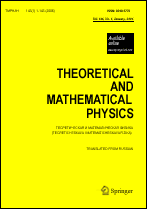|
This article is cited in 1 scientific paper (total in 1 paper)
Solving the modified Camassa–Holm equation via the inverse scattering transform
Hui Mao, Yu Qian, Yuanyuan Miao
School of Mathematics and Statistics, Nanning Normal University, Nanning, Guangxi, China
Abstract:
With the aid of the reciprocal transformation and the associated equation, we study the inverse scattering transform with a matrix Riemann–Hilbert problem for the modified Camassa–Holm (mCH) equation with nonzero boundary conditions (NZBC) at infinity. In terms of a suitable uniformization variable, the direct and inverse scattering problems are presented for the associated modified Camassa–Holm (amCH) equation. By means of the reciprocal transformation and the reconstruction formula for the potential of the amCH equation, we present the $N$-soliton solution for the mCH equation with NZBC. As applications, various solutions including both bright and dark types, smooth soliton solutions, singular soliton solutions, and multi-valued singular soliton solutions of the mCH equation and their interactions are exhibited.
Keywords:
modified Camassa–Holm equation, reciprocal transformation, inverse scattering transform, soliton solutions.
Received: 12.01.2023
Revised: 17.02.2023
Citation:
Hui Mao, Yu Qian, Yuanyuan Miao, “Solving the modified Camassa–Holm equation via the inverse scattering transform”, TMF, 216:2 (2023), 326–349; Theoret. and Math. Phys., 216:2 (2023), 1189–1208
Linking options:
https://www.mathnet.ru/eng/tmf10438https://doi.org/10.4213/tmf10438 https://www.mathnet.ru/eng/tmf/v216/i2/p326
|


| Statistics & downloads: |
| Abstract page: | 134 | | Full-text PDF : | 6 | | Russian version HTML: | 44 | | References: | 32 | | First page: | 12 |
|




 Contact us:
Contact us: Terms of Use
Terms of Use
 Registration to the website
Registration to the website Logotypes
Logotypes








 Citation in format
Citation in format 
